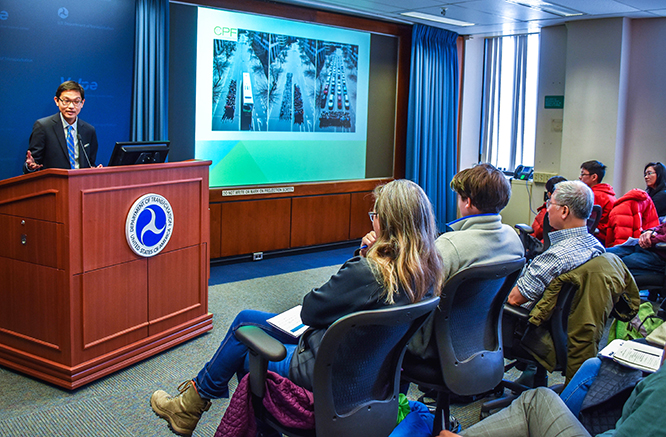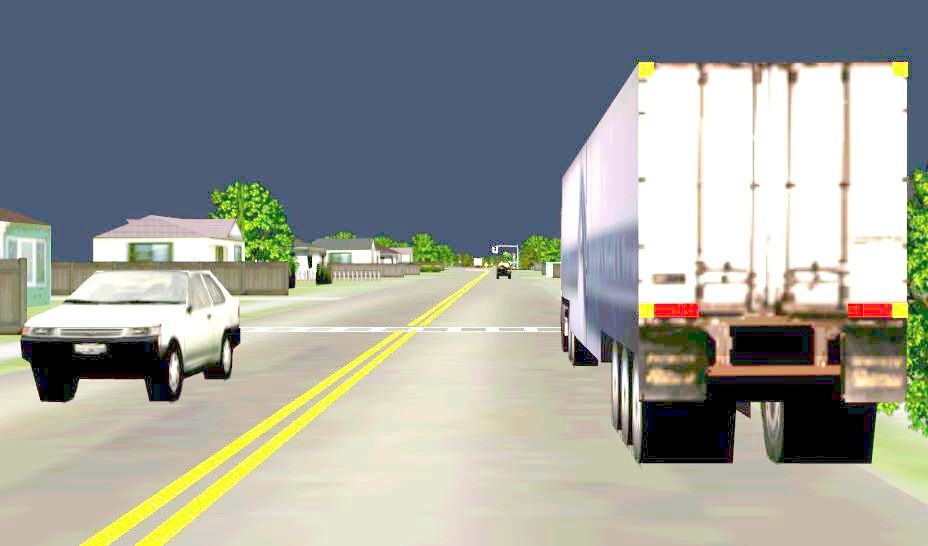Volpe Talks Transportation Solutions During Cambridge Science Festival
Showcasing the cutting edge in science, technology, engineering, art, and math (STEAM), the U.S. DOT Volpe Center introduced innovative solutions to transportation challenges to science fans of all ages as part of this year’s Cambridge Science Festival.
Emphasizing solutions focused on safety, infrastructure, innovation, and accountability, “Volpe Talks: Transportation Ideas Worth Sharing” featured five Volpe experts discussing multimodal projects, followed by a tour of Volpe’s train, airplane, and vehicle simulators to give the public first-hand experience with some of our work.
Maritime Safety and Security
The talks began with a close look at Volpe’s work in maritime vessel tracking with Kam Chin, chief of Volpe’s Situational Awareness and Logistics Division. Chin and his team develop and install vessel tracking systems that enable users all over the world to see where private and commercial vessels are at any given moment. This helps participating countries prevent collisions, improve search-and-rescue missions, and identify vessels that may be engaging in illegal activity.

Kam Chin, chief of Volpe’s Situational Awareness and Logistics Division, presents a map displaying tracked vessels around the globe. (Volpe photo)
Data Visualization and Road Safety
Data visualization is a powerful tool that can make data more understandable and accessible to colleagues and the public, said Michael Chang, a program analyst in Volpe’s Safety Measurement and Analysis Division.
“If you draw a good picture, more people can understand what they’re seeing,” Chang said. “Empower people to understand data, because collaboration is a must to solve complex problems.”
Using data visualization, Chang is able to see what months, days of the week, and times of day most fatal accidents occur on our nation’s roads. Federal and state agencies use this information to help prevent future crashes.
Improving Transportation in Sri Lanka
A key regional partner for the United States, Sri Lanka is located at the crux of several major trade routes, said Joseph Luna, a social scientist in Volpe’s Economic Analysis Division. Volpe collaborates with local and international stakeholders to evaluate transportation constraints and provide expertise to maintain economic growth and stability in the region.
“You want people and businesses to be able to move around easily, but technology alone doesn’t accomplish that,” Luna said. “You need to understand the incentives behind behaviors, so you couple the technical with knowledge of human behavior—Volpe does that.”

Volpe social scientist Joseph Luna demonstrates the positive impact that public transportation has on road congestion. (Volpe photo)
Automation and Public Transportation
A technology policy analyst in Volpe’s Technology Innovation and Policy Division, Joshua Cregger discussed how automation works and how it can be used in public transportation systems, such as transit buses and low-speed automated shuttles. Interest in this area has increased rapidly over the past few years, as many new demonstrations and pilots have been announced both domestically and internationally.
On behalf of the Federal Transit Administration (FTA) and the Intelligent Transportation Systems Joint Program Office (ITS JPO), Cregger and the Volpe team have reached out to various stakeholders involved in this area, including deployment communities across the country—such as cities, states, transit agencies, and universities—that are testing and introducing automated public transit vehicles.
The team has connected these communities with each other to share lessons learned and has helped them consider a variety of topics, such as how to conduct project evaluation and public outreach. These communities are working to understand how automated transit vehicles can provide service on both closed courses and public roads.
Dangers of Distracted Driving
To test the dangers of driving while distracted, Volpe human factors expert Dr. Donald Fisher uses an eye-tracker to observe where and at what drivers look while they are behind the wheel of a vehicle simulator. He then compares data of drivers driving with and without distractions to analyze how drivers view their surroundings while distracted by a phone call.
Describing one experiment conducted in a vehicle simulator, Fisher observed how distracted and non-distracted drivers viewed crosswalks and whether they were able to stop if a pedestrian walked into a crosswalk.
When drivers were not speaking on a cell phone, 90 percent of them looked for a pedestrian in a crosswalk. Only 20 percent of drivers on a cell phone looked for a pedestrian.

Volpe human factors staff observed middle-aged adults as they navigated this common road scene in a driving simulator. (Volpe image)
Simulators Tour
The Volpe Center campus features car, freight train, and commercial aircraft flight deck simulators used to conduct human factors experiments that investigate, among other things, how operators deal with complex situations.
After the presentations, Volpe’s guests got to experience the simulators for themselves.
For more information about other upcoming public events at Volpe, keep an eye on the Volpe Events page. You can also follow us on Twitter at @VolpeUSDOT.

